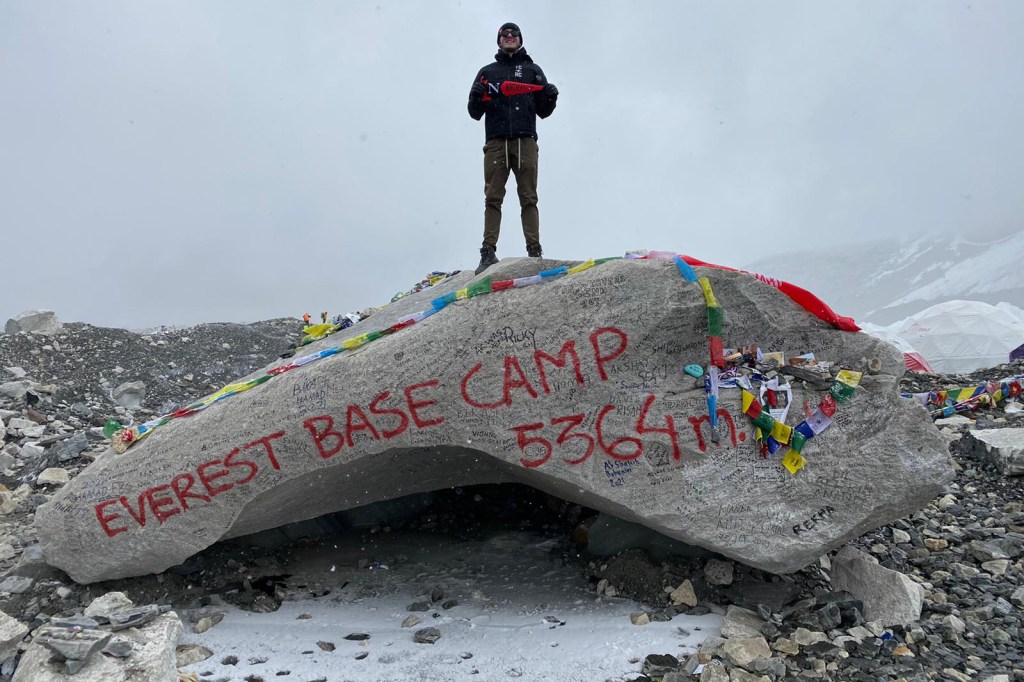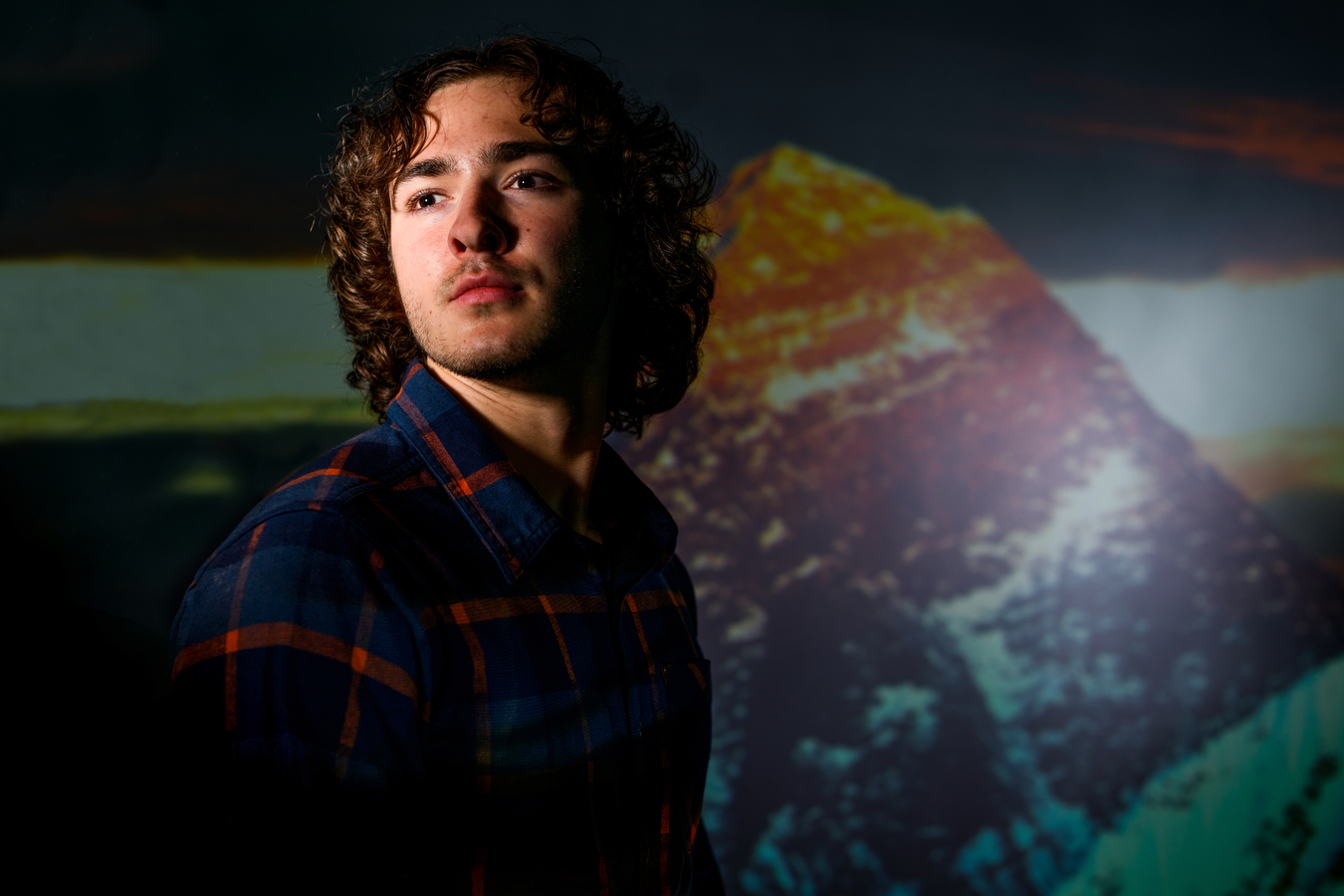Northeastern student’s climate research co-op on Mount Everest a ‘spectacular experience’

When Alexander Anderson was a junior in high school, he hiked to the summit of Mount Kilimanjaro, Africa’s highest peak at 19,341 feet above sea level.
So when the fourth-year Northeastern University student was searching for experiential learning opportunities last spring, he was thinking big—really big.
And it doesn’t get any bigger than Mount Everest, the tallest mountain on Earth.
Northeastern students participate in experiential learning programs in 148 countries on all seven continents. They pursue co-op positions across multiple industries, ranging from small startups to large corporations, including some of the most in-demand employers in the world, such as Amazon, Netflix and Google.
But Anderson, an environmental science and sustainability major from Minnesota studying on the Boston campus, may be the first to conduct research on Everest.
“It was such a spectacular experience,” he says.

Anderson’s co-op included a grueling two-week trek from the Khumbu region of Nepal to Everest Base Camp with the Himalayan Climate and Science Institute to support the installation of the world’s highest weather station.
Working with his co-op adviser, acclaimed polar explorer and climate activist Will Steger, Anderson completed high-altitude climate research and helped train Sherpa community members to service and maintain weather equipment that produces real-time data.
To get his co-op started, Anderson connected with Rick Silber, the executive director and co-founder of the Himalayan Climate & Science Institute.
“They were looking for some field scientists to run an environmental research project pertaining to climate change,” Anderson says. “I jumped at the opportunity.”
As part of his co-op, Anderson also mapped changes in seasonal glaciers, plotting their relationship to seasonal water levels of the Kosi River, which collects melting snow and ice from the northern slopes of the Himalayas.
Over the years, Anderson says, the mountains have produced less water as a result of climate change. At 29,032 feet, Everest is the Kosi’s biggest supplier.
“It doesn’t accumulate as much over the winter time,” he says. “Then, over the summer, the river recedes more and more.”
While on Mount Everest, Anderson witnessed a process called sublimation, which turns frozen water directly into water vapor before it melts.
“That’s all pretty much just lost glacial mass,” he says. “It doesn’t reaccumulate.”
What happens then, Anderson says, is the white color of the ice and snow is replaced with much darker rock, which doesn’t reflect light. And that accelerates the warming process.
“The mountain then absorbs more and more energy from the sun,” he says, “especially because it’s above the clouds.”
Anderson believes that most environmental issues, including those on Mount Everest, come down to water management.
“When you deplete aquifers, like the ones in the Himalayas, you grow a desert,” he says. “The region is losing a lot of net water content, but it’s not necessarily the amount of water that matters, it’s the seasonality of it. That is what accelerates climate change.”
Anderson was on Everest during the entire month of April when temperatures can range from -20 degrees Farenheit at night to the 60s and 70s during the day. The UV index (intensity of ultraviolet radiation from the sun) was 17, he says. Compare that to 6 on an average July day in Boston.
“It’s kinda shocking when you’re there,” Anderson says.
During his co-op, Anderson was required to check in every day with Northeastern’s global safety office using a satellite phone. He also texted his mom.
Anderson spent the first three months of his co-op in Boston preparing his research and studying satellite imagery. After that, he was part of a 14-day hike to Everest from Khumbu, the lush, mountainous region of northeastern Nepal. Each day, researchers covered about 12 miles, resting at encampments. The journey took them from 8,000 to 21,000 feet. Team members carried two weeks of supplies on their backs.
“It was exhausting,” Anderson says. “You’re gaining elevation every single day. It’s never just flat, always up or down.”
Along the way, researchers took the time to train natives to provide routine maintenance to the preexisting weather stations that are speckled throughout the Khumbu region.
“It’s currently really inefficient,” Anderson says. “All of these Western scientists have to fly in, collect the data and fix the equipment.”
The final day of the trip was the most difficult.
“The day that we got to base camp was definitely one of our hardest days,” Anderson says. “It was sleeting and we had to climb all these massive rocks.”
While at Everest Base Camp, Anderson met the first Iranian woman attempting to reach the summit and an officer in the British Special Air Services who was trying to scale Everest for the fourth time. His previous attempts were cut short when he had to rescue other climbers.
Attempts to reach the summit are done at night, Anderson says, when the ice shelves freeze.
“It’s too dangerous during the day,” he says. “You’re constantly hearing and seeing avalanches because it gets so hot.”
Anderson says that while his co-op was rewarding, using science to identify the reasons for climate change is only half the problem. There also needs to be follow-through.
“You actually have to act on it,” he says. “There’s always going to be people who aren’t going to be convinced by the research, but the science doesn’t lie.”
Anderson hopes his co-op inspires others to think outside the box.
“There are so many resources that are available to motivated students at Northeastern,” Anderson says. “I need to give kudos to the university for making this work. And not only making it work, but making it flourish.”
For media inquiries, please contact media@northeastern.edu.






